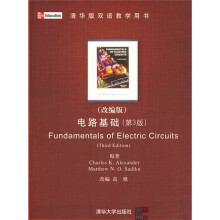A Note to the Student
About the Authors
PART 1 DC Circuits
Chapter 1Basic Concepts
1.1 Introduction
1.2 Systems of Units
1.3 Charge and Current
1.4Voltage
1.5 Power and Energy
1.6 Circuit Elements
1.7 tApplications
1.7.1 TV Picture Tube
1.7.2 Electricity Bills
1.8 tproblem Solving
1.9 Summary
Review Questions
Problems
Chapter 2Basic Laws
2.t Introduction
2.2 Ohms Law
2.3 Nodes, Branches, and Loops
2.4 Kirchhoffs Laws
2.5 Series Resistors and Voltage
Division
2.6 Parallel Resistors and Current
Division
2.7 Wye-Delta Transformations
2.8 tApplications
2.8.1 Lighting Systems
2.8.2 Design of DC Meters
2.9 Summary
Review Questions
Problems
ChapterMethods of Analysis
3.1 Introduction
3.2 Nodal Analysis
3.3 Nodal Analysis with Voltage
Sources
3.4 Mesh Analysis
3.5 Mesh Analysis with Current
Sources
3.6 tNodal and Mesh Analyses
by Inspection
3.7 Nodal Versus Mesh Analysis
3.8 tApplJcations
DC Transistor Circuits
3.9 Summary
Review Questions
Problems
Chapter4Circuit Theorems
4.t Introduction
4.2 Linearity Property/
4.3 Superposition
4.4 Source Transformation
4.5 Thevenins Theorem
4.6 Nortons Theorem
4.7 Maximum Power Transfer
4.8 Applications
4.8.1 Source Modeling
4.8.2 Resistance Measurement]
4.9 Summary
Review Questions
Problems
Chapter 5Capacitors and
Inductors
5.1 Introduction
5.2 CaPacitors
5.3 Series and Parallel Capacitors
5.4 Inductors
5.5 Series and Parallel Inductors
5.6 tApplications
Photoflash Unit
5.7 Summary
Review Questions
Problems
Chapter 6First-Order Circuits
6.1 Introduction
6.2 The Source-Free RCCircuit
6.3 The Source-Free RL Circuit
6.4 Singularity Functions
6.5 Step Response of an RCCircuit
6,6 Step Response of an .RL Circuit
6.7 Applications
6.7.1 Delay Circuits
6.7.2 Relay Circuits
6.8 Summary
Review Questions
Problems
Chapter 7Second-Order Circuits
7.1 Introduction
7.2 Finding Initial and Final Values
7.3 The Source-Free Series
RLCCircuit
7.4 The Source-Free Parallel RLC
Circuit
7.5 Step Response of a Series RLC
Circuit
7.6 Step Response of a Parallel RLC
Circuit
7.7 General Second-Order Circuits
7.8 tApplications
Automobile Ignition System
7.9 Summary
Review Questions
Problems
PART 2 AC Circuits
Chapter 8Sinusoids and Phasors
8.1 Introduction
8.2 Sinusoids
8.3 Phasors
8.4 Phasor Relationships for
Circuit Elements
8.5 Impedance and Admittance
8.6 Kirchhoffs Laws in the Frequency
Domain
8,7 Impedance Combinations
8.8 Applications
Phase-Shifters
8.9 Summary
Review Questions
Problems
Chapter 9Sinusoidal Steady-State
Analysis
9.1 Introduction
9.2 Nodal Analysis
9.3 Mesh Analysis
9.4 Superposition Theorem
9.5 Source Transformation
9.6 Thevenin and Norton Equivalent Circuits
9.7 tApplications
AC Bridges
9.8 Summary
Review Questions
Problems
Chapter 10 AC Power Analysis
10.1Introduction
10.2Instantaneous and Average
Power
10.3Maximum Average Power
Transfer
10.4Effective or RMS Value
10.5Apparent Power and
Power Factor
10.6Complex Power
10.7tConservation of AC Power
10.8Power Factor Correction
10.9Applications
10.9.l Power Measurement
10.9.2 Electricity Consumption Cost33]
10.10 Summary
Review Questions
Prohlems
Chapter 11 Three-Phase Circuits
……
PART 3

 缺书网
缺书网 扫码进群
扫码进群




